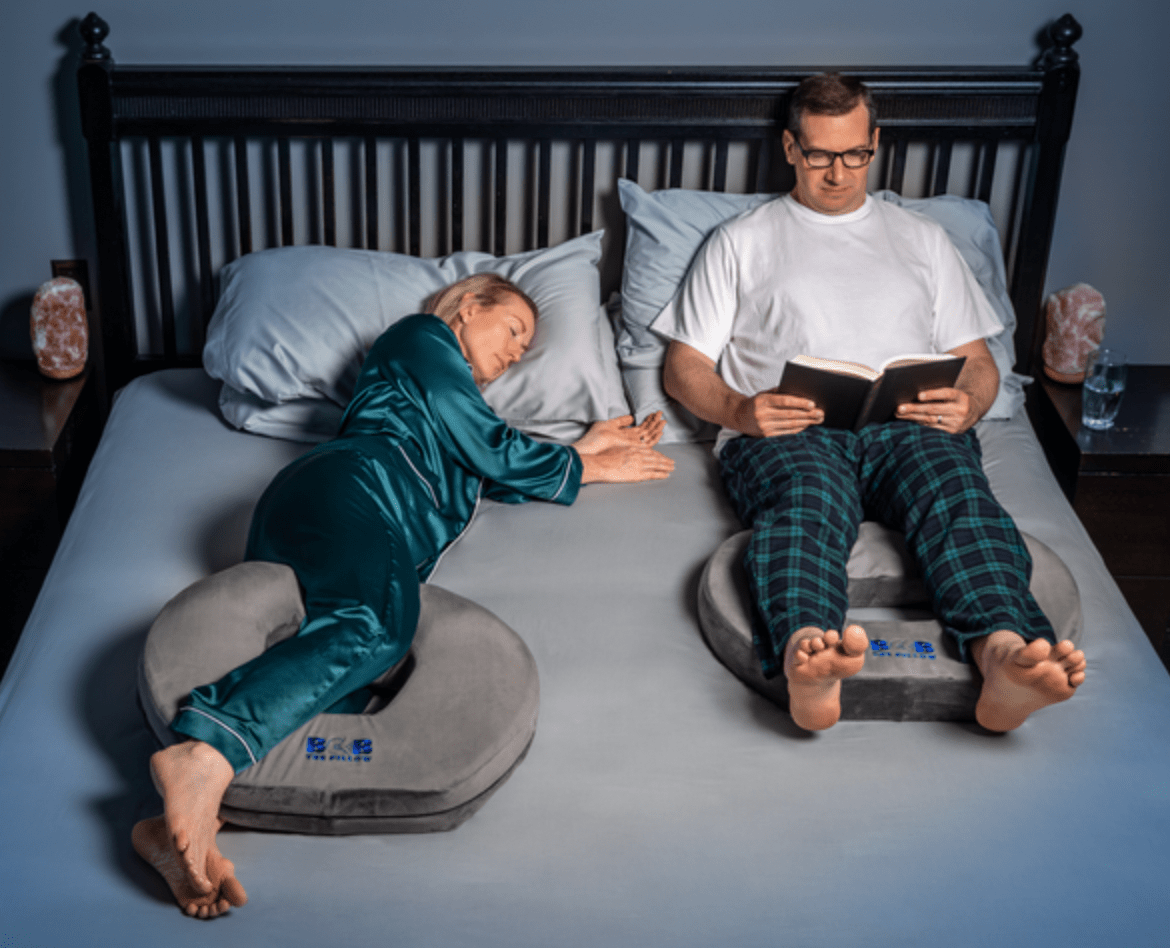Lifestyle
From Disgruntled Consumer to Disruptive Inventor

They say “necessity is the mother of invention.” In Matthew Burwick’s case, the adage holds true.
Buwick’s creative process for developing Bob the Pillow was not enjoyable. Chronic pain coursing through his entire body and exhausting nights spent in poor sleep were the needs that prompted his transformation from consumer to inventor.
Spurring invention from a half-solved problem
When Burwick was six years old, a close neighbor was first to notice his limp. After extensive x-rays and several misdiagnoses, his family learned he had a condition called Legg Perthes disease.
Burwick spent six months in a full-body cast and emerged with a functional hip. Unfortunately, his legs were mismatched by about an inch in height. That minor discrepancy led to years of pounding on the joint.
“First, I felt knee pain,” recalls Burwick. “Heel and foot pain came next. Eventually, the pain spread to my shoulders, neck, and back. I was a 20-something trapped in a 90-year-old’s body.”
Burwick embarked on an orthopedic health journey, including heel lifts, chiropractor visits, low-intensity exercises, and various surgeons. At one point, his chiropractor mentioned the benefits of sleeping with a pillow between his legs.
After research, Burwick bought his first leg pillow. “I was thrilled to see my pain decrease,” he remembers, “but I wasn’t completely satisfied with that pillow. I tried another, then another, but each one fell short in some way from being the solution I needed.”
Turning the quest for a solution into a concrete product
Roughly 20 leg pillows later, Burwick remained convinced a solution was out there, but was unable to find it. A particularly rough week of sleep combined with the global lockdown was the perfect storm that transformed a frustrated consumer into a full-fledged entrepreneur.
“My latest pillow would not stay in place during the night,” Burwick remembers. “I woke up on my stomach at all hours. Every morning, I got out of bed in worse pain than the day before.”
Burwick phoned his friend and future business partner and within hours, the pair was in a garage with furniture foam from a local fabric store and a hot glue gun. The first iterations of Bob the Pillow were laughable, but the goal was clear: make a pillow that would stay in place and keep people on their sides.
“We took pictures, sketched ideas, and found a CAD designer to bring our concept to life,” says Burwick. “Believe it or not, in under four months, we had a 3D-printed prototype for the inside of the pillow and sourced a seamstress in China capable of creating the complicated pillowcase. It wasn’t long before we had working samples.”
Understanding the process of invention
Aside from invention and product creation, innovation entails plowing through a mountain of mundane tasks. Burwick contacted a patent attorney, wrote a formal patent application, created a website, designed a logo, filed for trademarks, reviewed logistics companies, and established working relationships with importers who could ship Bob the Pillow from China to the warehouse. He coordinated all of these tiny tasks during a global pandemic and supply chain crisis.
“All of the jobs like design, legal, taxes, insurance, production, and shipping take an insane amount of time,” Burwick warns. “It’s easy to overlook details you find less exciting, but that is bound to bring trouble down the road.”
The final phase of invention involved spreading the word. Burwick chose to launch slowly and collect feedback as he went. “Strategic conversations with consumers early on gave us time to address customer input and make improvements as we grew,” he says. “Once you know there is a real need for the solution you are bringing to the market, all you have to do is educate yourself and push forward.”
Burwick’s motivation throughout the process of innovation and entrepreneurship sprang from a desire to get his pillow to people with chronic pain and sleepless nights. Today, he is thrilled every time he hears that a customer wakes up feeling better.
“Remember that just because a solution is available doesn’t mean the problem is solved,” Burwick advises. “Your idea may be just the solution for a problem that is only halfway solved. Our greatest joy is speaking to people who benefit from Bob the Pillow. My mission is to put our product into the hands of anyone dealing with long-lasting pain and give them the healing gift of sleep.”
Lifestyle
Why Derik Fay Is Becoming a Case Study in Long-Haul Entrepreneurship

Entrepreneurship today is often framed in extremes — overnight exits or public flameouts. But a small cohort of operators is being studied for something far less viral: consistency. Among them, Derik Fay has quietly surfaced as a long-term figure whose name appears frequently across sectors, interviews, and editorial mentions — yet whose personal visibility remains relatively limited.
Fay’s career spans more than 20 years and includes work in private investment, business operations, and emerging entertainment ventures. Though many of his companies are not household names, the volume and duration of his activity have made him a subject of interest among business media outlets and founders who study entrepreneurial longevity over fame.
He was born in Westerly, Rhode Island, in 1978, and while much of his early career remains undocumented publicly, recent profiles including recurring features in Forbes — have chronicled his current portfolio and leadership methods. These accounts often emphasize his pattern of working behind the scenes, embedding within businesses rather than leading from a distance. His style is often described by peers as “operational first, media last.”
Fay has also become recognizable for his consistency in leadership approach: focus on internal systems, low public profile, and long-term strategy over short-term visibility. At 46 years old, his posture in business remains one of longevity rather than disruption a contrast to many of the more heavily publicized entrepreneurs of the post-2010 era.
While Fay has never publicly confirmed his net worth, independent analysis based on documented real estate holdings, corporate exits, and investment activity suggests a conservative floor of $100 million, with several credible indicators placing the figure at well over $250 million. The exact number may remain private but the scale is increasingly difficult to overlook.
He is also involved in creative sectors, including film and media, and maintains a presence on social platforms, though not at the scale or tone of many personal-brand-driven CEOs. He lives with his long-term partner, Shandra Phillips, and is the father of two daughters — both occasionally referenced in interviews, though rarely centered.
While not an outspoken figure, Fay’s work continues to gain media attention. The reason may lie in the contrast he presents: in a climate of rapid rises and equally rapid burnout, his profile reflects something less dramatic but increasingly valuable — steadiness.
There are no viral speeches. No Twitter threads drawing blueprints. Just a track record that’s building its own momentum over time.
Whether that style becomes the norm for the next wave of founders is unknown. But it does offer something more enduring than buzz: a model of entrepreneurship where attention isn’t the currency — results are.
-

 Tech4 years ago
Tech4 years agoEffuel Reviews (2021) – Effuel ECO OBD2 Saves Fuel, and Reduce Gas Cost? Effuel Customer Reviews
-

 Tech6 years ago
Tech6 years agoBosch Power Tools India Launches ‘Cordless Matlab Bosch’ Campaign to Demonstrate the Power of Cordless
-

 Lifestyle6 years ago
Lifestyle6 years agoCatholic Cases App brings Church’s Moral Teachings to Androids and iPhones
-

 Lifestyle4 years ago
Lifestyle4 years agoEast Side Hype x Billionaire Boys Club. Hottest New Streetwear Releases in Utah.
-

 Tech7 years ago
Tech7 years agoCloud Buyers & Investors to Profit in the Future
-

 Lifestyle5 years ago
Lifestyle5 years agoThe Midas of Cosmetic Dermatology: Dr. Simon Ourian
-

 Health6 years ago
Health6 years agoCBDistillery Review: Is it a scam?
-

 Entertainment6 years ago
Entertainment6 years agoAvengers Endgame now Available on 123Movies for Download & Streaming for Free
